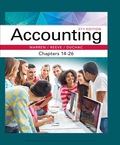
Accounting, Chapters 14-26
27th Edition
ISBN: 9781337514095
Author: Carl Warren, James M. Reeve, Jonathan Duchac
Publisher: Cengage Learning
expand_more
expand_more
format_list_bulleted
Question
Chapter 20, Problem 20.23EX
To determine
Lean Manufacturing
The main objective of lean manufacturing is to yield products with high quality, low cost, and immediate availability. In attempting to achieve this objective many producers have applied lean manufacturing.
To Explain: The way in which the managers would be responded.
Expert Solution & Answer
Trending nowThis is a popular solution!

Students have asked these similar questions
Financial accounting
Please help me solve this general accounting problem with the correct financial process.
MCQ
Chapter 20 Solutions
Accounting, Chapters 14-26
Ch. 20 - Which type of cost system, process or job order,...Ch. 20 - In job order cost accounting, the three elements...Ch. 20 - Prob. 3DQCh. 20 - Why is the cost per equivalent unit often...Ch. 20 - What is the purpose for determining the cost per...Ch. 20 - Rameriz Company is a process manufacturer with two...Ch. 20 - What is the most important purpose of the cost of...Ch. 20 - Prob. 8DQCh. 20 - Prob. 9DQCh. 20 - Prob. 10DQ
Ch. 20 - Job order versus process costing Which of the...Ch. 20 - Job order versus process costing Which of the...Ch. 20 - Units to be assigned costs Eve Cosmetics Company...Ch. 20 - Units to be assigned costs Keystone Steel Company...Ch. 20 - Equivalent units of materials cost The Filling...Ch. 20 - Equivalent units of materials cost The Rolling...Ch. 20 - Equivalent units of conversion costs The Filling...Ch. 20 - Equivalent units of conversion costs The Rolling...Ch. 20 - Cost per equivalent unit The cost of direct...Ch. 20 - Cost per equivalent unit The cast of direct...Ch. 20 - Cost of units transferred out and ending work in...Ch. 20 - Cost of units transferred out and ending work in...Ch. 20 - Process cost journal entries The cost of materials...Ch. 20 - Process cost journal entries The cost of materials...Ch. 20 - Using process costs for decision making The costs...Ch. 20 - Using process costs for decision making The costs...Ch. 20 - Entries for materials cost flows in a process cost...Ch. 20 - Flowchart of accounts related to service and...Ch. 20 - Entries for flow of factory costs for process cost...Ch. 20 - Factory overhead rate, entry for applying factory...Ch. 20 - Equivalent units of production The Converting...Ch. 20 - Equivalent units of production Units of production...Ch. 20 - Equivalent units of production The following...Ch. 20 - Costs per equivalent unit a. Based on the data in...Ch. 20 - Equivalent units of production Kellogg Company...Ch. 20 - Costs per equivalent unit Georgia Products Inc....Ch. 20 - Equivalent units of production and related costs...Ch. 20 - Cost of units completed and in process a. Based on...Ch. 20 - Errors in equivalent unit computation Napco...Ch. 20 - Cost per equivalent unit The following information...Ch. 20 - Costs per equivalent unit and production costs...Ch. 20 - Cost of production report The debits to Work in...Ch. 20 - Cost of production report The Culling Department...Ch. 20 - Cost of production and journal entries AccuBlade...Ch. 20 - Cost of production and journal entries Lighthouse...Ch. 20 - Process costing for a service company Madison...Ch. 20 - Decision making Mystic Bottling Company bottles...Ch. 20 - Decision making Fix Paper Inc. produces...Ch. 20 - Prob. 20.23EXCh. 20 - Equivalent units of production: average cost...Ch. 20 - Equivalent units of production: average cost...Ch. 20 - Equivalent units of production: average cost...Ch. 20 - Equivalent units of production and related costs...Ch. 20 - Cost per equivalent unit: average cost method The...Ch. 20 - Cost of production report: average cost method The...Ch. 20 - Cost of production report: average cost method...Ch. 20 - Entries for process cost system Pori Ormond Carpel...Ch. 20 - Cost of production report Arabica Highland Coffee...Ch. 20 - Equivalent units and related costs; cost of...Ch. 20 - Work in process account data for two months; cost...Ch. 20 - Cost of production report: average cost method...Ch. 20 - Entries for process cost system Preston Grover...Ch. 20 - Cost of production report Bavarian Chocolate...Ch. 20 - Equivalent units and related costs; cost of...Ch. 20 - Work in process account data for two months; cost...Ch. 20 - Cost of production report: average cost method...Ch. 20 - Ethics in Action Assume that you are the division...Ch. 20 - Communication Jamarcus Bradshaw, plant, manager of...Ch. 20 - Accounting for materials costs In papermaking...Ch. 20 - Analyzing unit costs Midstate Containers Inc....
Knowledge Booster
Similar questions
- Nirvana Technologies has $85,000 in assets. They also have $32,000 in liabilities and $8,500 in expenses, and they paid out $10,000 in dividends this year. The extended accounting equation is assets = liabilities + (revenue - (expenses + dividends)). What would their revenue need to be for their accounts to be in balance?arrow_forwardThe per unit manufacturing cost under absorption costing is?arrow_forwardI need help with this financial accounting problem using proper accounting guidelines.arrow_forward
- Please explain the correct approach for solving this general accounting question.arrow_forwardPlease help me solve this financial accounting question using the right financial principles.arrow_forwardI am looking for the most effective method for solving this financial accounting problem.arrow_forward
arrow_back_ios
SEE MORE QUESTIONS
arrow_forward_ios
Recommended textbooks for you
 Managerial AccountingAccountingISBN:9781337912020Author:Carl Warren, Ph.d. Cma William B. TaylerPublisher:South-Western College Pub
Managerial AccountingAccountingISBN:9781337912020Author:Carl Warren, Ph.d. Cma William B. TaylerPublisher:South-Western College Pub Cornerstones of Cost Management (Cornerstones Ser...AccountingISBN:9781305970663Author:Don R. Hansen, Maryanne M. MowenPublisher:Cengage Learning
Cornerstones of Cost Management (Cornerstones Ser...AccountingISBN:9781305970663Author:Don R. Hansen, Maryanne M. MowenPublisher:Cengage Learning

Managerial Accounting
Accounting
ISBN:9781337912020
Author:Carl Warren, Ph.d. Cma William B. Tayler
Publisher:South-Western College Pub

Cornerstones of Cost Management (Cornerstones Ser...
Accounting
ISBN:9781305970663
Author:Don R. Hansen, Maryanne M. Mowen
Publisher:Cengage Learning